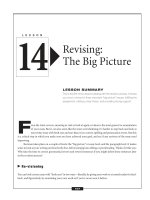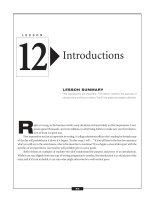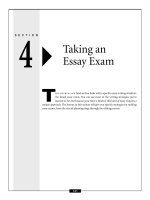Write Better Essays - Outlining and Organizational Strategies
Bạn đang xem bản rút gọn của tài liệu. Xem và tải ngay bản đầy đủ của tài liệu tại đây (110.58 KB, 14 trang )
N
ow that you have a tentative thesis, you may be tempted to jump right in and start drafting. Some-
times, this approach works, especially if you’ve done a lot of brainstorming, have thought care-
fully about your assignment, and your writing skills are strong. More often, however, a great essay
is the product not only of brainstorming, but of organization as well.
The Assertion
➞
Support Structure
Before discussing common organizational strategies, it’s important to consider the underlying structure of essays.
Whether an essay is organized by chronology, comparison and contrast, cause and effect, or some other strategy,
every essay has the same underlying structure: assertion
➞
support. That is, the essay asserts an idea (its thesis)
and then supports the thesis with specific examples, evidence, and details.
This assertion
➞
support structure is then repeated throughout the essay on many levels. The ideas that pro-
vide support for the thesis (major support) are assertions themselves, and therefore need support. The structure
then looks something like this:
LESSON
Outlining and
Organizational
Strategies
LESSON SUMMARY
In this lesson, you’ll learn about the underlying structure of an essay and
how to create an outline. We’ll also examine some of the common orga-
nizational strategies used by essay writers.
6
49
Main idea (thesis)
Major supporting idea
Minor supporting idea
Support
Minor supporting idea
Support
Major supporting idea
Minor supporting idea
Support
The exact underlying structure will vary depending upon the number and type of supporting ideas, but in all its
variations, it is the foundation for most essays.
The Benefits of an Outline
Generating an outline before you draft an essay will help you in several ways. First, it will give structure to your
ideas. By mapping out the order in which those ideas will flow, you create a roadmap for the drafting process. The
roadmap assures that you won’t veer off topic, helps prevent writer’s block, and speeds up drafting.
Second, an outline will help you determine where you need more support for your thesis. When you create
an outline, you’ll be able to see any gaps in the development of your ideas. Strongly supported assertions stand
out in contrast to weaker ones.
Third, an outline will help judge the plausibility of your thesis. If you jump into drafting without organiz-
ing first, you may find during the writing process that your thesis doesn’t hold up. A good outline can help you
revise, modify, and/or strengthen your thesis before you begin writing. Specifically, a good outline will tell you if
your thesis is:
■
too broad. If you have trouble including everything in your outline, you probably have too much to say.
Your thesis needs to be more focused.
■
too narrow. If you can’t seem to find enough to say, your thesis might be too focused. You need to broaden it
to create a viable essay.
■
unreasonable. If there isn’t sufficient evidence to support your thesis, you should reconsider its viability.
You may need to take a different stance.
■
underdeveloped. If you have many gaps in our outline, you may need to do more thinking or research to
find sufficient support.
–OUTLINING AND ORGANIZATIONAL STRATEGIES–
50
Kinds of Outlines
If you have to drive somewhere you’ve never been before, you could just get in the car and start driving, hoping
your sense of direction will be enough to land you at your destination. More likely, though, you will consult a map
and write down some directions. But how carefully should you plan your trip? Do you want to map out each gas
station where you’ll need to fill up, and each rest stop where you’ll get coffee? Or do you simply need a list of route
numbers and turns you’ll need to take?
How thoroughly you map out your trip depends on many different factors, such as your familiarity with the
terrain and the distance you’ll be traveling. The same is true in writing. Do you need a detailed, formal outline
that lists every major and minor supporting idea, or just a rough “scratch” outline? Again, the answer depends upon
several factors, including how comfortable you are with your thesis, how well you follow a structured outline, and
how many ideas you’ve developed through you brainstorming sessions. It also depends upon the writing situa-
tion. During a timed essay exam, you’ll only have time to make a list of paragraphs and, very generally, what you’ll
write about in each one.
Informal Outlines
An informal, rough,or scratch outline is one that lists only the major supporting ideas in the order in which you
think you should develop them. Here’s an example on an informal outline.
Assignment: Evaluate the proposal to replace the current graded income tax system with a flat tax. Should we insti-
tute a flat tax system? Why or why not?
1. Introduction—thesis: A flat tax would be good for the government and for citizens.
2. Problems with current system
3. How flat tax works
4. Benefits of flat tax system
a. for government
b. for citizens
5. Conclusion
This outline provides a general structure for a draft. It’s not very detailed—it doesn’t include the minor sup-
porting ideas or specific examples the essay needs to be fully developed, but it can function well as a roadmap to
guide the writer through a first draft.
–OUTLINING AND ORGANIZATIONAL STRATEGIES–
51
Formal Outlines
A formal outline is much more detailed. It includes specific, supporting details and several levels of support. Here’s
a part of a formal outline for the same assignment:
I. Describe problems with the current system.
A. complex
1. tax rates vary greatly
2. too many intricate details
B. unfair
1. deductions, loopholes, special interests
2. people with same income can pay different amount of taxes
C. wasteful
1. different forms for different people
2. huge administrative costs
3. huge compliance costs
4. advising costs
II. How flat tax works
A. all citizens pay same rate—17%—for income over a set minimum
B. all citizens get same personal exemption
C. no breaks for special interest
D. no loopholes
III. Benefits
A. citizens
1. sense of fairness—all treated equally
2. poorest pay no taxes
3. simple to calculate and file
4. families save more
5. more faith in government
6. people will save and invest more
B. government
1. streamline IRS
a. reduce cost
i. fewer employees
ii. less paper, printing, etc.
iii. less auditing costs
2. healthier economy
–OUTLINING AND ORGANIZATIONAL STRATEGIES–
52
Common Organizational Strategies
Essay organization doesn’t stop, however, with the underlying assertion
➞
support structure and an outline. A
number of effective strategies can organize your information and ideas, comprising a logical, easy-to-understand
flow for your essay.
Chronological/Sequential
One way to organize your material is by chronology,or time sequence. Put ideas in the order in which they hap-
pened, should happen, or will happen. This method works best when you are narrating or describing an experi-
ence, procedure, or process. Imagine writing about the way a bill is passed in Congress, but the steps needed to
complete the process are out of chronological or sequential order. The point or points you are trying to make about
that process will get lost in the ensuing confusion.
Here is a sample rough outline using chronology as its organizing principle.
Assignment: Describe a time when you and a family member experienced a deep sense of conflict or when you sharply
disagreed about an important issue. What caused the conflict? What was the outcome? Have your feelings about the
matter changed or remained the same? Explain.
Tentative thesis: When I decided to become a vegetarian, my parents refused to support me. It was very difficult to
stick to my decision—but I’m glad I did.
Rough outline:
1. telling my family
2. their reactions
3. trying to explain my reasons
4. flashback: taking the “virtual tour” of the slaughterhouse on the Web
5. offering to take my family on the tour, but only Wei watching it with me
6. Mom and Dad refusing to cook special meals for me
7. learning to cook for myself
8. Wei accepting my decision and trying some vegetarian meals with me
9. Wei giving up meat too
10. Mom and Dad accepting our decision and supporting us
Practice 1
On a separate sheet of paper or your computer, create an outline using chronology as your organizational prin-
ciple. Your outline can be rough or formal. Use one of your brainstorms from Lesson 3 or 4, or one of the brain-
storms provided as an example to create your outline.
–OUTLINING AND ORGANIZATIONAL STRATEGIES–
53









